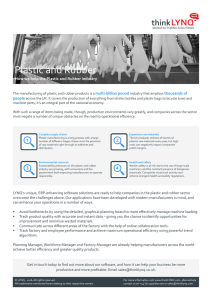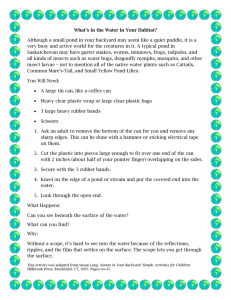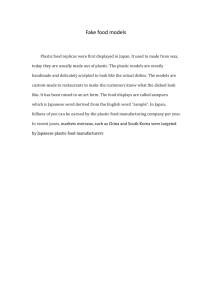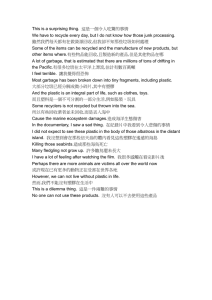IRJET- Use of Plastic Aggregate and Crumb Rubber in Flexible Pavement
advertisement
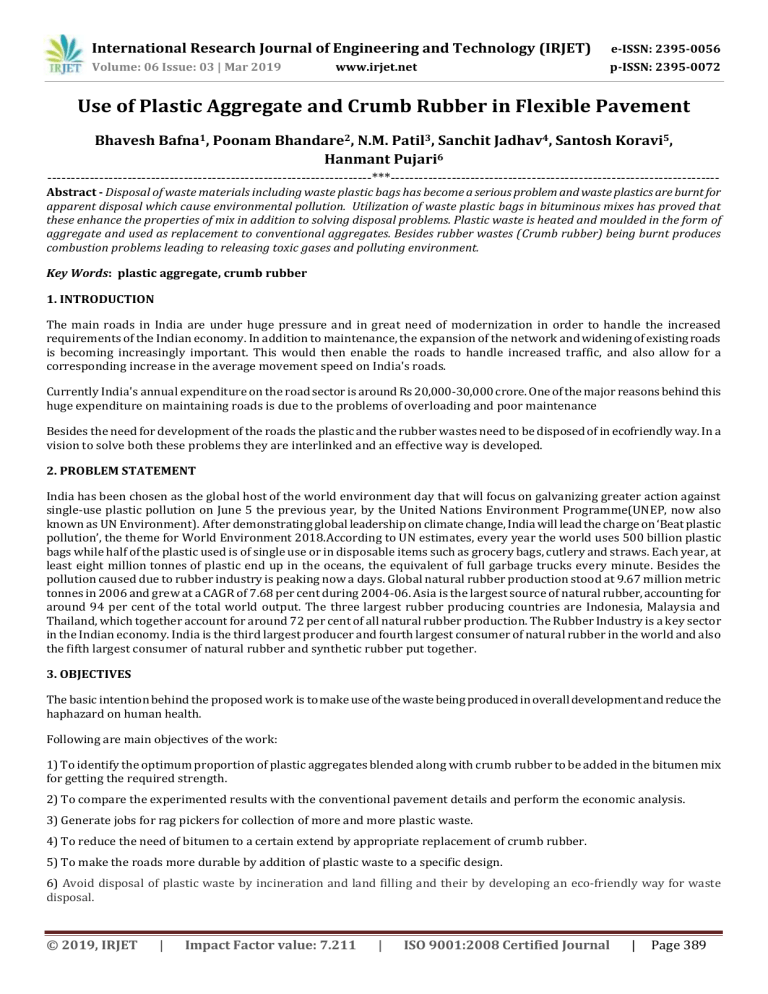
International Research Journal of Engineering and Technology (IRJET) e-ISSN: 2395-0056 Volume: 06 Issue: 03 | Mar 2019 p-ISSN: 2395-0072 www.irjet.net Use of Plastic Aggregate and Crumb Rubber in Flexible Pavement Bhavesh Bafna1, Poonam Bhandare2, N.M. Patil3, Sanchit Jadhav4, Santosh Koravi5, Hanmant Pujari6 ---------------------------------------------------------------------***---------------------------------------------------------------------- Abstract - Disposal of waste materials including waste plastic bags has become a serious problem and waste plastics are burnt for apparent disposal which cause environmental pollution. Utilization of waste plastic bags in bituminous mixes has proved that these enhance the properties of mix in addition to solving disposal problems. Plastic waste is heated and moulded in the form of aggregate and used as replacement to conventional aggregates. Besides rubber wastes (Crumb rubber) being burnt produces combustion problems leading to releasing toxic gases and polluting environment. Key Words: plastic aggregate, crumb rubber 1. INTRODUCTION The main roads in India are under huge pressure and in great need of modernization in order to handle the increased requirements of the Indian economy. In addition to maintenance, the expansion of the network and widening of existing roads is becoming increasingly important. This would then enable the roads to handle increased traffic, and also allow for a corresponding increase in the average movement speed on India's roads. Currently India's annual expenditure on the road sector is around Rs 20,000-30,000 crore. One of the major reasons behind this huge expenditure on maintaining roads is due to the problems of overloading and poor maintenance Besides the need for development of the roads the plastic and the rubber wastes need to be disposed of in ecofriendly way. In a vision to solve both these problems they are interlinked and an effective way is developed. 2. PROBLEM STATEMENT India has been chosen as the global host of the world environment day that will focus on galvanizing greater action against single-use plastic pollution on June 5 the previous year, by the United Nations Environment Programme(UNEP, now also known as UN Environment). After demonstrating global leadership on climate change, India will lead the charge on ‘Beat plastic pollution’, the theme for World Environment 2018.According to UN estimates, every year the world uses 500 billion plastic bags while half of the plastic used is of single use or in disposable items such as grocery bags, cutlery and straws. Each year, at least eight million tonnes of plastic end up in the oceans, the equivalent of full garbage trucks every minute. Besides the pollution caused due to rubber industry is peaking now a days. Global natural rubber production stood at 9.67 million metric tonnes in 2006 and grew at a CAGR of 7.68 per cent during 2004-06. Asia is the largest source of natural rubber, accounting for around 94 per cent of the total world output. The three largest rubber producing countries are Indonesia, Malaysia and Thailand, which together account for around 72 per cent of all natural rubber production. The Rubber Industry is a key sector in the Indian economy. India is the third largest producer and fourth largest consumer of natural rubber in the world and also the fifth largest consumer of natural rubber and synthetic rubber put together. 3. OBJECTIVES The basic intention behind the proposed work is to make use of the waste being produced in overall development and reduce the haphazard on human health. Following are main objectives of the work: 1) To identify the optimum proportion of plastic aggregates blended along with crumb rubber to be added in the bitumen mix for getting the required strength. 2) To compare the experimented results with the conventional pavement details and perform the economic analysis. 3) Generate jobs for rag pickers for collection of more and more plastic waste. 4) To reduce the need of bitumen to a certain extend by appropriate replacement of crumb rubber. 5) To make the roads more durable by addition of plastic waste to a specific design. 6) Avoid disposal of plastic waste by incineration and land filling and their by developing an eco-friendly way for waste disposal. © 2019, IRJET | Impact Factor value: 7.211 | ISO 9001:2008 Certified Journal | Page 389 International Research Journal of Engineering and Technology (IRJET) e-ISSN: 2395-0056 Volume: 06 Issue: 03 | Mar 2019 p-ISSN: 2395-0072 www.irjet.net 4. EXPERIMENTAL WORK For checking the quality of material following tests were conducted as enlisted above as per the standard specification: A) Tests for aggregate (For conventional as well as plastic aggregate) 1. Aggregate Abrasion Test 2. Specific Gravity & Water Absorption Test [IS: 2386 (Part 3) 1963] 3. Aggregate Impact Value Test [IS: 2386 (part 4) 1963] 4. Aggregate Crushing Value [IS: 2386 (Part 4) 1963] 5. Flakiness & Elongation Index Test [IS: 2386 (part 1) 1963] B) Tests for bitumen (for modified as well as conventional) 1. Penetration Test [IS: 1203-1978] 2. Softening Point Test [IS: 1205-1978] 3. Ductility Test [IS: 1208-1978] 4. Viscosity Test 5. RESULT ANALYSIS After complete experimental work we can observe the effect of replacement of bitumen by crumb rubber. The mix turns out to become stiffer and this results in increased durability of the pavement and hence the life of pavement. The variation of properties is as shown in fig: 1 below: Fig: 1 Comparison of properties of modified and conventional bituminous mix. The average value of the above properties is determined for each mix with different bitumen content and the following graphical plots are prepared: 1. Binder content versus corrected Marshall Stability 2. Binder content versus Marshall Flow 3. Binder content versus percentage of void (Vv) in the total mix 4. Binder content versus voids filled with bitumen (V FB) 5. Binder content versus unit weight or bulk specific gravity (Gm) Due to variation in the plastic aggregate percentage following additional graphs are to be added 1. 2. 3. 4. 5. Plastic Aggregate percentage vs corrected Marshall Stability. Plastic Aggregate percentage vs Marshall Flow. Plastic Aggregate percentage vs percentage of void (Vv) in the total mix. Plastic Aggregate percentage vs voids filled with bitumen (V FB). Plastic Aggregate percentage vs unit weight or bulk specific gravity (Gm) © 2019, IRJET | Impact Factor value: 7.211 | ISO 9001:2008 Certified Journal | Page 390 International Research Journal of Engineering and Technology (IRJET) e-ISSN: 2395-0056 Volume: 06 Issue: 03 | Mar 2019 p-ISSN: 2395-0072 www.irjet.net Fig: 2 Percentage of plastic aggregate vs Marshall Stability Value Fig: 4 Percentage of plastic aggregate vs Bulk Specific Gravity (Gm) Fig: 3 Percentage of plastic aggregate vs Percentage of void (Vv) Fig: 5 Binder Content vs Marshall Stability Value © 2019, IRJET | Impact Factor value: 7.211 | ISO 9001:2008 Certified Journal | Page 391 International Research Journal of Engineering and Technology (IRJET) e-ISSN: 2395-0056 Volume: 06 Issue: 03 | Mar 2019 p-ISSN: 2395-0072 www.irjet.net Fig: 6 Binder Content vs Bulk Specific Gravity (Gm) Fig: 8 Binder Content vs Percentage of Void (Vv) Fig: 7 Percentage of plastic aggregate vs Void with Bitumen (VFB) Fig: 9 Percentage of plastic aggregate vs Marshall Flow Value © 2019, IRJET | Impact Factor value: 7.211 | ISO 9001:2008 Certified Journal | Page 392 International Research Journal of Engineering and Technology (IRJET) e-ISSN: 2395-0056 Volume: 06 Issue: 03 | Mar 2019 p-ISSN: 2395-0072 www.irjet.net Fig: 10 Binder Content vs Void filled with bitumen (VFB) Fig: 11 Binder Content vs Marshall Flow Value 6. CONCLUSION Plastic aggregates are used for the better performance of roads. This helps to have a better binding of bitumen with plastic wasted coated aggregate due to increased bonding and increased area of contact between polymers and bitumen. The polymer coating also reduces the voids. This prevents the moisture absorption and oxidation of bitumen by entrapped air. This has resulted in reducing rutting, raveling and there is no pothole formation. The roads can Withstand heavy traffic and show better durability. Following are some points which are drawn from the study: 1. Softening point of the plain bitumen was found to be increased by significant amount and it is advantageous to use instead of plain bituminous mix. 2. After mixing crumb rubber to bituminous mix they acquire additional stiffness which makes the overall composite more durable. 3. After complete analysis of the graph we can conclude that roads can be made by 100% plastic aggregate and 5% replacement of bitumen without any decrease in strength. 4. Stripping Value was reduced from 1% for control specimen to nil and remained same for additional 5%crumb rubber and 10% Crumb rubber to bituminous mix. This shows that additional 5% crumb rubber is more suitable for bituminous construction than plain bituminous mixes. In short we can conclude that, using plastic waste in mix will help reduction in need of bitumen by around 10%, increase the strength and performance of road, avoid use of anti-stripping agent, avoid disposal of plastic waste by incineration and land filling and ultimately develop a technology, which is ecofriendly. Increased traffic conditions will and are reducing the life span of roads. Plastic roads are means of prevention and ultimately will be the cure. It will save environment and reduce the amount of resources used for construction. © 2019, IRJET | Impact Factor value: 7.211 | ISO 9001:2008 Certified Journal | Page 393 International Research Journal of Engineering and Technology (IRJET) e-ISSN: 2395-0056 Volume: 06 Issue: 03 | Mar 2019 p-ISSN: 2395-0072 www.irjet.net REFERENCES 1. Al-Hadidy A.I., Yi-qiu Tan (2009), “Effect of polyethylene on life of flexible pavements”, Construction and Building Materials, Vol. 23. 2. Verma S. S., (Nov. 2008), “Roads from plastic waste”, Science Tech Entrepreneur, the Indian Concrete Journal, P.No.43 - 44. 3.Yue Huang, Roger N. Bird, Oliver Heidrich 2.,(2007), “A review of the use of recycled solid waste materials inasphalt pavements”, Resources, Conservation and Recycling, Vol.52, School of Civil Engineering and Geosciences, Newcastle University, UK, pp 58-73. 4. I.Vegas, J.A. Iban˜ez, J.T. San Jose´, A. Urzelai., (2008), “Construction demolition wastes, Waelz slag and MSWIbottom ash: A comparative technical analysis as material for road construction”, Waste Management, Vol. 28, pp565–574 5.Bandopandhyay T. K., (Jan. - Mar. 2010), “Construction of Asphalt Road with Plastic Waste”, Indian Center forPlastic in Environment (ICPE), ENVIS – Eco- Echoes, Vol.11, Issue 1. 6. S.K. Khanna and C.E.G Justo “Highway Engineering” 2008. 7. A.I.AI Hadidy, Tan Yi-qui, (2009) “Effects of polyethylene on life of flexible pavements” 1456- 1464, Construction and Building materials 23. 8. L.R Schroceder, “The Use of Recycled Materials in Highway construction’, Public Roads, Vol 58(Issue 2), 1994 8. S.S. Verma. “Roads from Plastic Waste”, the Indian Concrete Journal, p. 43-44.November 2008. © 2019, IRJET | Impact Factor value: 7.211 | ISO 9001:2008 Certified Journal | Page 394

